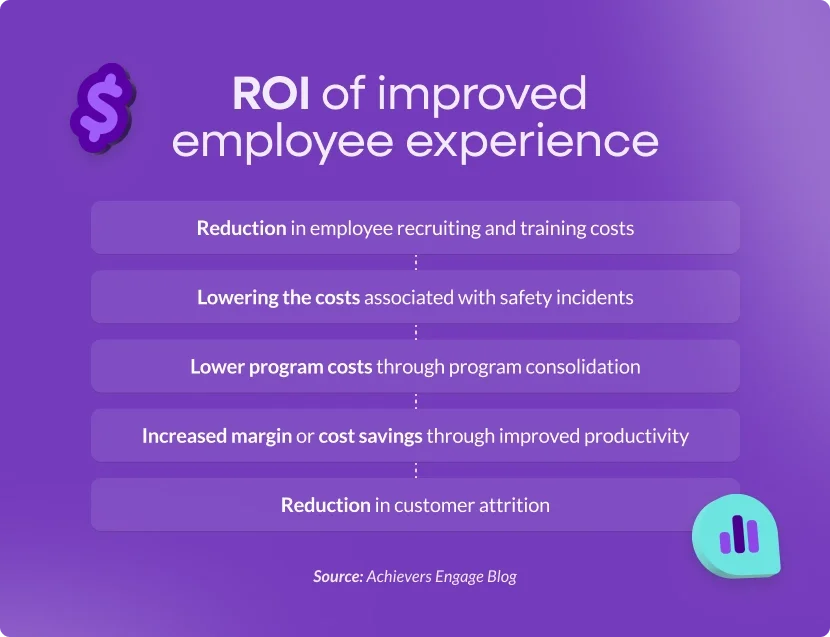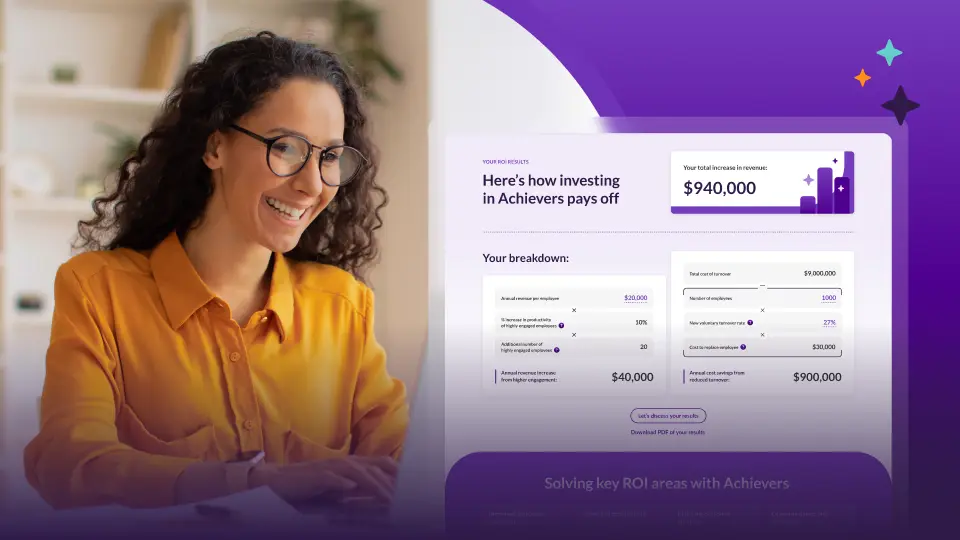Table of contents
Business decisions are grounded in data — insights that steer you toward smart investments and help you avoid poor ones. At the core of every investment choice is ROI, or return on investment, which measures the value (financial or otherwise) gained relative to what you’ve invested. Calculating ROI offers a clear view of whether an initiative — like a new employee experience program — is bringing measurable benefits to the business. For employee experience, you need the assurance that any program will yield real, quantifiable results. Once it’s underway, tracking progress, staying agile, and adapting as needed are essential to maximizing that ROI.
In this blog, we’ll dive into why employee experience is worth the investment, outlining major benefits like reduced hiring costs, better productivity, and lower customer churn — plus practical ROI formulas so you can measure the impact every step of the way.
Why should you invest in employee experience?
Traditionally, businesses have relied on metrics like ROI, net present value (NPV), or internal rate of return (IRR) to decide where to allocate funds — usually aiming for cost savings or revenue growth. But now, a new area is emerging as a top investment: employee experience.
Companies that invest in employee experience reap significant benefits, from higher productivity to reduced turnover. At the heart of this is employee recognition, which is no longer just a “nice-to-have” but a critical driver of engagement and performance. Recognition directly links to improved business outcomes, making it a key differentiator for high-performing organizations.
For example, organizations with highly-rated cultures of recognition are 2.5 times more likely to see improved employee engagement — a critical factor in productivity and retention. By leveraging employee engagement software to streamline and enhance recognition, companies can see measurable improvements in morale, retention, and innovation — all translating to a strong return on investment.
“Recognition is an integral part of the culture we have built, and we have done the analysis that shows it is an important driver of the strong Associate engagement we have at CHRISTUS.”
– Ron Croy
Vice President and Chief Talent Officer, CHRISTUS Health
Setting the stage: Why recognition matters
Most HR leaders agree: recognition is a cornerstone for driving engagement, and engagement is critical to an organization’s success. In fact, a striking 71% of executives believe that employee engagement plays a significant role in achieving business goals.
In the past, measuring something as elusive as employee engagement was a challenge — let alone actually boosting it. But that’s changing. Today, engagement is no longer an intangible concept. With the right tools at your disposal, connecting the dots becomes a breeze, helping HR leaders have impactful conversations with C-suite to secure support for a more modern recognition strategy.
Recognition isn’t just a one-off event; it’s an ongoing necessity that needs to be met consistently — weekly, or even daily. For example, Achievers users are 4x more likely to be recognized multiple times a month compared to other providers. This consistent recognition fosters a positive correlation with engagement, meaning that Achievers customers are not only happier but also perform better and contribute to more favorable business outcomes.
Statistics that show recognition improves engagement
In a thriving workplace where recognition is abundant, every achievement—big or small—is celebrated, leading to significant improvements in engagement. Studies reveal that for each time an organization doubles its number of recognitions, overall employee engagement is expected to rise by 5 points
This increase in engagement translates directly to productivity. Engaged employees are 17% more productive than their disengaged peers, creating a positive ripple effect throughout the organization. Higher engagement leads to less turnover, creating a stable workforce filled with motivated team members. It fosters productive teams that collaborate effectively and innovate boldly.
And it doesn’t stop there — this culture of recognitionalso translates into greater customer satisfaction. Happy employees create happy customers, resulting in enhanced business performance. In this thriving environment, recognition becomes more than just a nice gesture; it’s the heartbeat of a successful organization, driving productivity and satisfaction on every level.
“One recognition per employee every 30 days seems to be the tipping point associated with the most predictable improvements to retention and other key metrics, such as customer satisfaction or performance scores.”
– Achievers Workforce Institute (AWI)
What is the value of employee experience?
Understanding the value of employee experience goes far beyond surface-level perks; it directly influences organizational success and the bottom line. Employee experience is a complex concept that includes daily interactions, workplace culture, and the tools and resources employees need to excel in their roles.
For example, research from Harvard Business Review revealed that improving employee experience metrics in customer-facing departments could increase revenue by over 50%. This shows that when organizations prioritize enhancing employee experience, they create an environment that not only boosts job satisfaction but also enhances engagement and productivity. Employees who feel valued and supported are more likely to be committed and efficient, leading to reduced turnover rates, lower recruitment costs, and higher revenues.
Additionally, a positive employee experience fosters innovation and adaptability, which are crucial for maintaining a competitive edge in today’s market. To truly quantify the value of employee experience, it’s essential to consider both tangible benefits, such as increased productivity and decreased hiring expenses, and intangible benefits, like employee morale and brand reputation. Together, these factors contribute significantly to a stronger organizational ROI, making a compelling case for investing in the overall employee experience.

The benefits and ROI of improved employee experience
While many benefits are shared across sectors, each has their primary focus. Here are just a few of the ways that the Achievers platform helps organizations drive an improved employee experience. Quantifiable benefits include:
1. Reduction in employee recruiting and training costs
Increased employee engagement creates an attractive work environment in which employees thrive and choose to stay.
How to measure: Expected improvement in turnover rate [%] x Cost to replace an employee [$] x Total number of employees in impacted population [#]*
Case study snapshot: Meijer, a family-owned superstore based out of the U.S. Midwest, wanted to understand the impact of employee recognition on retention and use these insights to keep their best employees.
The result: Through their use of the Achievers Employee Experience Platform™, Meijer was able to identify that recognition had a direct correlation on employee retention. Those who stayed at the company had significantly higher recognition rates than those who left.
2. Lowering costs associated with safety incidents
In manufacturing and healthcare environments, employee, guest, and patient safety are paramount. High levels of employee engagement are shown to result in safer work environments.
How to measure: Expected improvement in safety incident rate [%] x Average number of annual safety incidents [#] x Cost per safety incident [$]*
Case study snapshot: Deeply concerned about the health and safety of their patients, CHRISTUS Health implemented a Near Miss/Zero Harm program to encourage the encourage the reporting of incidents that could have caused harm. These reports are used to adjust policies and procedures to ensure greater patient safety.
The result: Using their Achievers program to execute this important initiative, CHRISTUS Health saw a six-fold rise in near miss reporting — an outstanding improvement considering that often, near miss incidents go unreported, putting patients at risk.
3. Lower program costs through program consolidation
By consolidating all recognition and rewards initiatives into a single platform, organizations increase the visibility of recognition and reward spend, enabling the reallocation of budget from low impact activities to high impact initiatives.
How to measure: Total current spend across all business units and regions [$] – Cost of single consolidated program [$]*
- Calculate the total cost of running individual rewards/recognition programs, excluding the cost of the rewards being paid out (e.g., software fees, headcount to run all the separate programs)
- Subtract the cost of running a single program (e.g., software fee, headcount to run a single program)
Case study snapshot: Power Design, an electrical contracting company, wanted a program that provided efficiency around awards reconciliation, saving time, effort, and money.
The result: By streamlining their recognition programs and housing them all in one place through the Achievers platform, Power Design is afforded more time to learn from each program, identify and execute process improvements, and breathe new life into them with fresh ideas and approaches.
4. Increased margin or cost savings through improved productivity
Highly engaged employees are measurably more productive than less engaged employees. And that productivity, if driving customer satisfaction improvements, manifests itself as an increased margin due to higher revenues, or, if driving increased employee efficiencies, results in lower employee costs.
How to measure: Expected productivity increase per highly engaged employee [%] x Increase in % of highly engaged employees [%] x Revenue per employee [$] x Margin [%]*
Case study snapshot: Genesis Hospitality, a collection of hotel chains, aimed to increase productivity and sales through a focus on employee recognition and engagement.
The result: Suite upsells increased by 62%. In addition, Genesis was named one of Achievers 50 Most Engaged Workplaces and became one of Canada’s Best Managed Companies two years in a row.
5. Reduction in customer attrition
Acquiring new customers is costly. Achievers helps organizations retain customers and maintain a more stable revenue stream through improved employee engagement that drives customer satisfaction.
How to measure: Improvement in number of customers retained x Average revenue per customer / Expected reduction in customer attrition [%] x Cost of acquiring a new customer [$]*
Case study snapshot: A national retailer known for innovation in food and retail practices sought to impact their customer satisfaction by leveraging the connection between employee engagement and customer loyalty. Utilizing Achievers, the organization drove business success through recognizing employee contributions, aligning them to business objectives and corporate values, and engaging them every day.
The result: Within the first six months, the retailer experienced a 112% increase in customer satisfaction scores across its stores. A remarkable 70% of the stores achieved a 90% customer satisfaction rating — up from just 33% of stores at the early stages of the program.
*Calculations have been simplified for demonstration purposes. To understand the dynamic calculations required to curate a complete picture of your quantifiable benefits, contact us.
Find out the ROI of your business’s employee experience
Investing in employee experience is not just a trend; it’s a strategic decision that directly influences your organization’s ROI. The data is clear: companies that prioritize employee recognition and engagement see significant benefits, from reduced hiring costs to increased productivity and customer satisfaction.
To understand and harness these benefits, organizations must measure and track their initiatives effectively. Achievers’ ROI calculator empowers you to quantify the impact of your employee experience programs, ensuring that every investment you make translates into tangible returns. Don’t leave your ROI to chance; calculate it today and discover the value Achievers can add to your business through enhanced engagement and retention.



